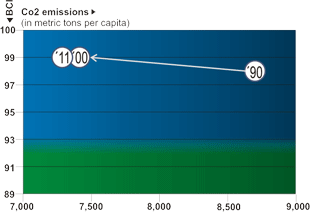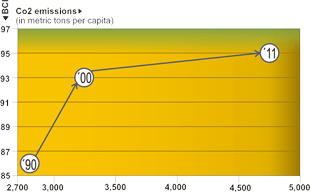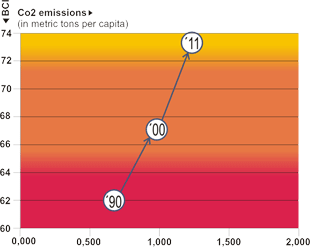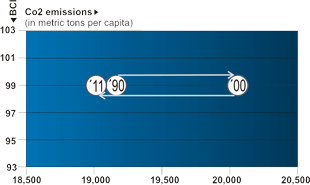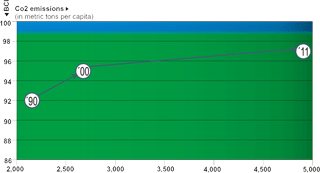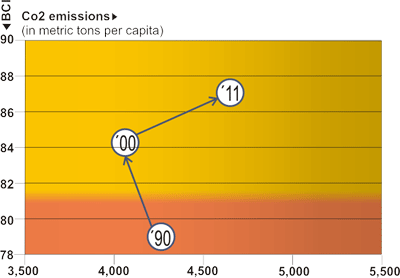Basic Capabilities Index 2011
|
|||||||||
|
|
|||||||||
|
|||||||||
FOR THE PRESS PRESS RELEASE - Economic growth does not ensure human well-being PRESS RELEASE - The boom and the busted PRESS RELEASE - A lost decade in the fight against poverty PRESS RELEASE - The virtuous few: clean and dignified |
|||||||||
BCI Trends by Component Indicators
The child mortality index has the highest values across countries and regions. The reproductive health index and education index have similar values which are significantly lower compared to the child mortality index. Globally, the 2011 population weighted average value of the child mortality index is computed at 95.7. In comparison, the corresponding value for education is 78.5 and 75.7 for the reproductive health. That means more efforts are needed to address the gaps and significantly improve education and reproductive health.
Table belows shows the average values of the component indicators for years 1990, 2000 and 2011 and by region weighted by population.
Table 1. BCI by Component Indicators
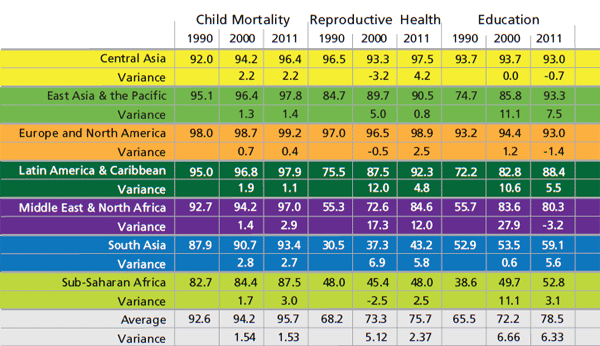
Notes:
1) All values are weighted by population
2) There may be some discrepancies in the average values of the component indicators due to the rescaling process that was used to correct for distortions due to missing data, particularly for year 1990
It should be noted that the global trends in the last twenty years for all three component indicators show a similar pattern of increases from 1990 to 2000 and 2011. However, reflecting the same pattern as the BCI, the progress is slower during the period 2000 to 2011 compared to the previous decade. That means that there is a noted slowdown in the progress achieved by countries starting 2000. This pattern is also seen in most of the regions, indicating quite a consistent trend of slowing down over the past decade.
BCI Trends by Region, 1990, 2000 & 2011
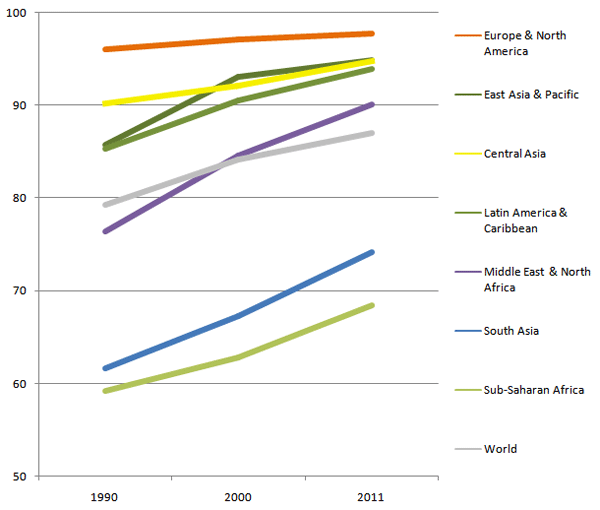
Graphic: Social Watch
By region, the trend also reflects the global slowdown in terms of increases in the BCI level.
There is only marginal change in BCI level for Europe and North America in the last 20 years. For the regions of Latin America and the Caribbean, East Asia and the Pacific, and the Middle East and North Africa, the trend shows a significant slowing down of progress in BCI during the period 2000 to 2011 compared to the previous decade.
On a positive note, the regions of Central Asia, South Asia, and Sub-Saharan Africa registered slightly higher increments in BCI levels in the period of 2000-2011 compared to the previous decade. Despite the higher momentum for the poorer countries in the Sub-Saharan Africa and South Asia, it must be noted that this two regions have the lowest BCI recorded. Both these regions started from very low levels, and they need to accelerate even more if they are to reach average basic levels in the next decade. South Asia is progressing faster than Sub-Saharan Africa.
BCI Trends, 1990 to 2011 – Slowing Down
The global BCI has progressed between 1990 and 2011, although, in general, there is slower rate of progress between 2000 and 2011 than between 1990 and 2000. In 1990, the average BCI value (population weighted) for countries with available data was 79.4. In 2000, BCI increased by 4.9 points to 84.3. BCI further increased to 87.1 by 2011, but at a lower increment of 2.8 points – lower than the increment posted in the previous decade.
Global BCI Trend, 1990-2011
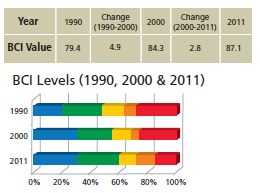
Looking at the regional trends, it is noted that in the past 20 years from 1990 to 2011, more countries have achieved basic and medium BCI levels. During the same period, the number of countries with critical BCI level has decreased from 42 countries in 1990 to only 28 by 2011. Some of these countries advanced to the next level while a few have actually moved two levels higher.
The number of countries with medium BCI levels increased from 44 in 1990 to 52 in 2011. Countries that have scaled up their BCI levels from low/very low to medium include the following: Algeria, Iran, Kuwait, Saudi Arabia, Syria and Tunisia (Middle East and North Africa); Azerbaijan, Tajikistan, Maldives and Vietnam (Central, South and East Asia); and Belize, Brazil, Colombia, El Salvador, Mexico, Paraguay, Peru and Suriname (Latin America). El Salvador registered the highest increment in BCI in this group accounting for a 17 point increase for the period 1990 to 2011. In contrast, countries such as Ukraine, Bosnia and Herzegovina, and Thailand have moved down from basic BCI to medium level.
Nineteen (19) countries registered low BCI levels in 2011. Countries such as Bolivia, Honduras and Nicaragua in Latin America, and Cape Verde, Zimbabwe, and Swaziland in the Sub-Saharan Africa region, improved their standing from very low/critic BCI level to low BCI. Within this group of countries that registered low BCI levels, Bhutan in South Asia recorded the highest increase of 28 points, climbing up from critical to low BCI level.
The number of countries in the critical BCI list has declined since 1990 to only 28 by 2011. Countries such as Benin, Cameroon, Eritrea, Ghana, Kenya, Malawi, Rwanda, Tanzania and Togo in Sub-Saharan Africa; Guatemala in Latin America; Djibouti, Egypt, Morocco and Yemen in the Middle East and North Africa; Laos and Myanmar in East Asia; and Bhutan and India in South Asia, have moved up from their previous critical BCI levels. Nonetheless, the number of countries in the critical list remains substantial especially if one considers that many poor countries with no reliable data collection system, indicating poor functioning institutions, would more likely fall in the critical BCI levels.
BCI and Co2 emissions by region
Social Progress and Environmental Damage
The Basic Capabilities Index and CO2 emissions
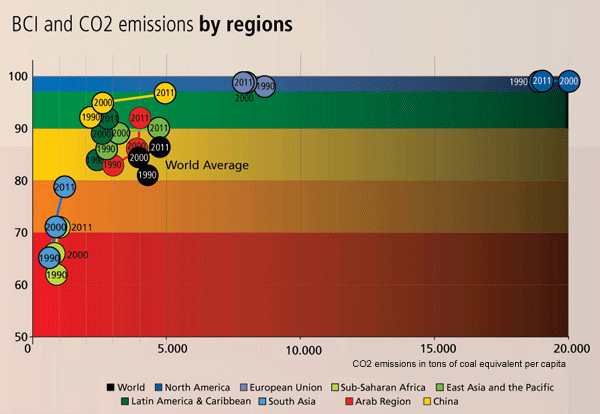
Sub-Saharan Africa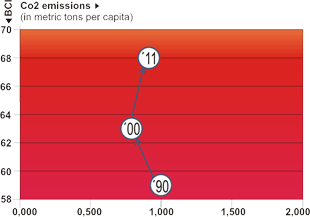 |
Latin America and the Caribbean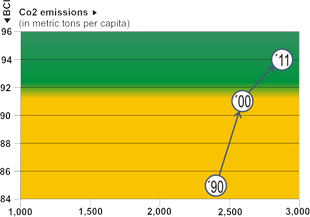 |
|
Arab countries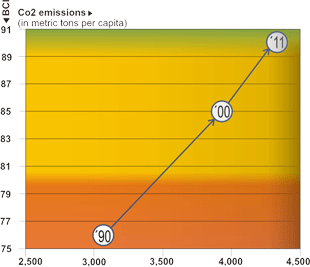 |
European Union
|
|
| East Asia and the Pacific
|
South Asia
|
|
| North America
|
China
|
|
| World
|
||
The vertical axis shows the situation in the BCI (infant mortality, primary education, attended births), which has a maximum value of 100. The horizontal axis shows per capita emissions of Co2 in tons of coal equivalent |
||
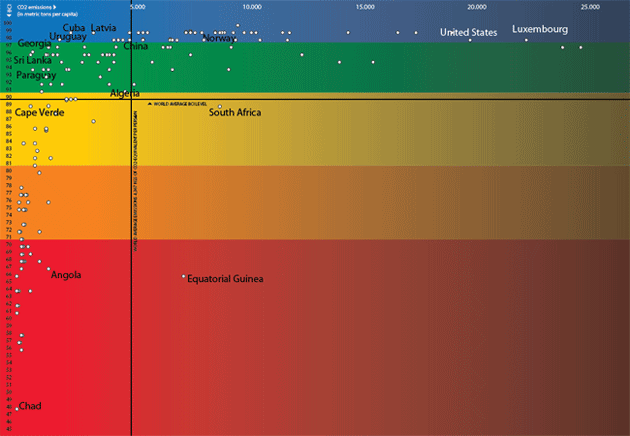
Technical Notes
The following are the indicators used for computing the Basic Capabilities Index:
1. Under-five mortality rate. Under-5 mortality rate is defined as the probability of a child born in a specific year or period to die before reaching the age of five, if subject to age-specific mortality rates of that period, that is, a probability of death derived from a life table and expressed as a rate per 1,000 live births (Health statistics and health information systems, World Health Organization accessed from <www.who.int/healthinfo/statistics/indunder5mortality/en>). We express this indicator by subtracting x/1000 from 100, where x is the number of deaths under-5 per 1000 live births. Data for this indicator were obtained from UNICEF State of the World’s Children 2011.
2. Births attended by skilled health personnel. This is defined as the percentage of live births attended by skilled health personnel in a given period of time. Data for this indicator were mainly obtained from Global Health Observatory Data Repository (World Health Organization), and from the UN official website for MDG indicators and UNdata 2003-2008 (<data.un.org/Data.aspx?q=births+attended+by+skilled+personnel&d=SOWC&f=inID%3a21>) was used for countries with no data available from the WHO. Data were imputed for first world countries (such as Germany, Norway, US, etc.) which have no available data from the sources mentioned.
3. Education. The education indicator consists of three sub-indicators:
a. Adult literacy rate. The adult literacy rate is the percentage of population aged 15 and above who can both write and read a short simple statement on their everyday life. It is calculated by dividing the number of literates (aged 15+) by the corresponding population age group and multiplying the result by 100 (UNESCO Institute for Statistics Glossary, <glossary.uis.unesco.org/glossary/en/home>).
b. Primary Net Enrollment Rate (NER). This is defined as the enrollment of the official age group expressed as a percentage of the corresponding population, which is calculated by dividing the number of pupils (or students) enrolled who are of the official age group for primary level by the population for the same age group and multiplying the result by 100 (UNESCO Institute for Statistics Glossary, <glossary.uis.unesco.org/glossary/en/home>).
c. Survival rate to fifth grade. This is the percentage of a cohort of pupils enrolled in the first grade of a given level or cycle of education in a given school year who are expected to reach fifth grade (UNESCO Institute for Statistics Glossary, <glossary.uis.unesco.org/glossary/en/home>).
The main source for these sub-indicators is the UNESCO Institute for Statistics (UIS) data centre, <stats.uis.unesco.org/unesco/TableViewer/document.aspx?ReportId=136&IF_Language=eng&BR_Topic=0>. The earliest data available from 1990 to 1995 were used for the year 1990, data available from 1998 to 2002 were used for the year 2000, and the latest available data from 2005 to 2011 were used for the year 2011. Data for the year 1990 were mainly gathered from Global Monitoring Report 2010 and World Bank database, since data from UIS were only available from 1999, except for the adult literacy rate indicator. Data not available from UIS and GMR were obtained from the Economic Commission for Latin America and the Caribbean (ECLAC), 2010 Statistical Yearbook for Latin America and the Caribbean in <www.eclac.org/cgi-bin/getProd.asp?xml=/publicaciones/xml/7/42167/P42167.xml&xsl=/deype/tpl-i/p9f.xsl&base=/tpl-i/top-bottom.xslt>, accessed on May 2011 and from the United Nations Statistics Division, <unstats.un.org/unsd/demographic/products/indwm/tab5e.htm> accessed on May 2011. Since there are many missing data for the Survival rate to fifth grade indicator, survival rate to the last grade of primary school (also obtained for UIS) was considered for countries with no data.
Data for each sub-indicator were rescaled from 0 to 100 using the following formula which was adopted from HDR. After rescaling all the values of each sub-indicator, the education indicator is computed by averaging three rescaled sub-indicators, if three have values, or taking the average of two, if one has missing value. No value is given if more than one sub-indicator is absent.
Rescaling was also done for the two other indicators - Under-five mortality rate and Maternal health indicators. The raw BCI value is computed by taking the average of the rescaled values of the three indicators, if all three have values, and the average of two indicators, if only two have values. No value is given if more than one indicator is missing.
The index values expressed from 0 to 100 are then “rescaled back” to put the values back into the original range of BCI values so that comparison with previous BCI calculation becomes possible.
(1) The BCI/GEI Technical Group is composed of the research team from Action for Economic Reforms (AER) and Social Watch Philippines (SWP) - Rene Raya, Maria Luz Aniagan, Karla Machel Raya and Alvelyn Joy Berdan
The Basic Capabilities Index: It is not about money
The Basic Capabilities Index (BCI) was designed by social watch as an alternative way to monitor the situation of poverty in the world. Most of the available poverty-measurement is based on the premise that poverty is a monetary phenomenon and they measure, for example, how many persons live with an income of less than one dollar a day.
The BCI is an alternative non-monetary measure of poverty and well-being based on key human capabilities that are indispensable for survival and human dignity. The indicators that make up the BCI are among the most basic of those used to measure the Millennium Development Goals (MDGS).The BCI assigns equal weight to three Basic Capabilities: (1) the capability to be well-nourished;(2) the capability for healthy and safe reproduction; (3) and the capability to be educated and be knowledgeable. The index is computed as the average of three indicators: 1) mortality among children under five, 2) reproductive or maternal-child health (measured by births attended by skilled health personnel), and 3) education (measured with a combination of enrolment in primary education, the proportion of children reaching fifth grade and adult literacy rate).
All the indicators are expressed in percentages and they range from 0 to 100. under-five mortality, which is usually expressed in number of deaths per thousand children born alive, is expressed as 100 minus that value. so that, for example, a value of 20 deaths per thousand becomes 2% and, when deducted from 100, yields a basic indicator value of 98. Thus, the theoretical maximum value in infant mortality is 100, which would mean that all children born alive survive until they are five years old. reproductive health takes the maximum value 100 when all women giving birth are attended by skilled health personnel. similarly, the education indicator registers 100 when all school age children are enrolled in education and they all attain five years of schooling. These three indicators are then averaged, so the total value of the index will vary between 0% and 100%.
BCI for 2011
Countries with basic BCI level have reached a reasonable level of human development and have basically met the MDG targets way ahead of the 2015 deadline. Countries with medium BCI level have achieved a certain level of momentum to address key human development concerns and have a fair chance of meeting the MDG targets by 2015. Countries with low BCI level are still struggling to provide basic services for their citizens and will more likely miss the MDG targets by 2015. Countries with very low and critical BCI levels will certainly miss the MDG targets. Most of these countries, particularly those with critical BCI level, are experiencing severe economic difficulties, social unrest or wars. Some have just emerged from armed conflict and are still transitioning to normalize government operations and public services.
The boom and the busted - A lost decade in the fight against poverty

| WORLD TRADE TOTAL WORLD EXPORTS MULTIPLIED ALMOST FIVE TIMES IN TWENTY YEARS, GROWING FROM A TOTAL VALUE OF 781 BILLION US DOLLARS IN 1990 TO 3.7 TRILLION IN 2010. |
PER CAPITA INCOME THE WORLD AVERAGE INHABITANT MORE THAN DOUBLED HER INCOME FROM 4.079 US DOLLARS IN 1990 TO 9.116 DOLLARS A YEAR IN 2010. |
BASIC CAPABILITIES INDEX THE WORLD AVERAGE IN THE INDEX OF ESSENTIAL SOCIAL INDICATORS COMPUTED BY SOCIAL WATCH ONLY GREW 10% IN TWENTY YEARS, FROM 79.3 TO 87.1 |
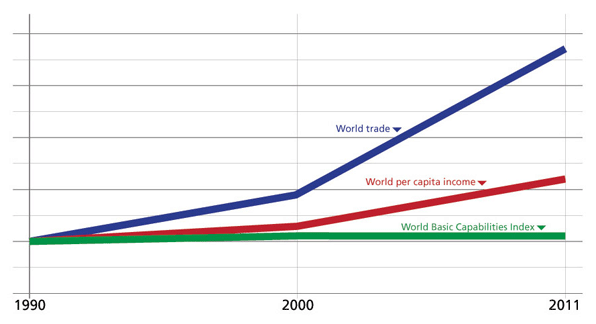
World trade and per capita income grew faster in the first decade of the xxI century than the decade before, but progress against poverty slowed down. A gap widened, due to the unequal distribution of the benefits of prosperity. Now the boom years seem to give way to a bust. The vulnerable did not benefit from the accelerated growth in the economy, but they will undoubtedly suffer the most with a new contraction. The Basic Capabilities Index computed by social watch looks at basic social indicators. The 2011 figures show that economic performance and well being of the people do not go hand in hand. Progress on education, health and nutrition was already too slow when gross income was growing fast. While using the latest available figures, the Index does not
capture yet the whole impact of the global financial and economic crisis that started in 2008, because social indicators are gathered and published much slower than the economic numbers. yet, social watch is receiving evidence from its members on how the crisis is burdening the most those already vulnerable and that situation can only become worse if the big industrialized countries enter into prolonged stagnation or recession.
The world turns right instead of moving up
With carbon dioxide emissions of three tons of per capita a year, Costa Rica and Uruguay have managed to lower their infant mortality to the same level of a country that emits twenty tons a year: the United States. At the same time, with the same level of emissions than Norway, South Africa has a set of social indicators similar to that of Indonesia, which consumes five times less fossil fuels.
The notion that eradicating poverty and reaching basic dignity for all requires a model of development that destroys the environment is wrong. The leaders of the world made that point in Rio twenty years ago at the “Earth Summit” and stated that “the major cause of the continued deterioration of the global environment is the unsustainable pattern of consumption and production, particularly in industrialized countries (...) aggravating poverty and imbalances”.
Between 1990 and 2000 the world’s index of basic capabilities improved five points (from 79 to 84) while the world per capita emissions of CO2 actually decreased from 4.3 tons to 4.1. In the first decade of the XXI century, world CO2 emissions moved up to 4.6 tons per capita but the social indicators only moved up 3 points. In spite of the declared commitment with poverty eradication and the Millennium Development Goals, the year 2000 was a turning point for the worse: social progress slowed down while environmental destruction accelerated.


